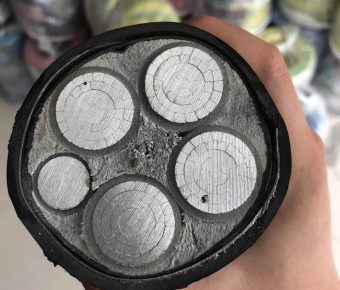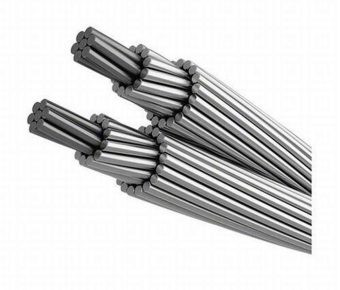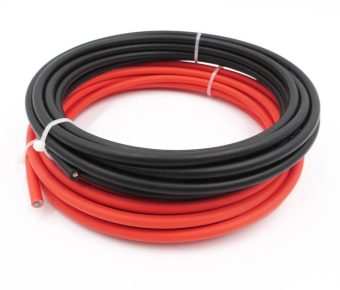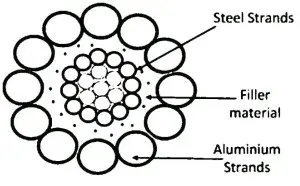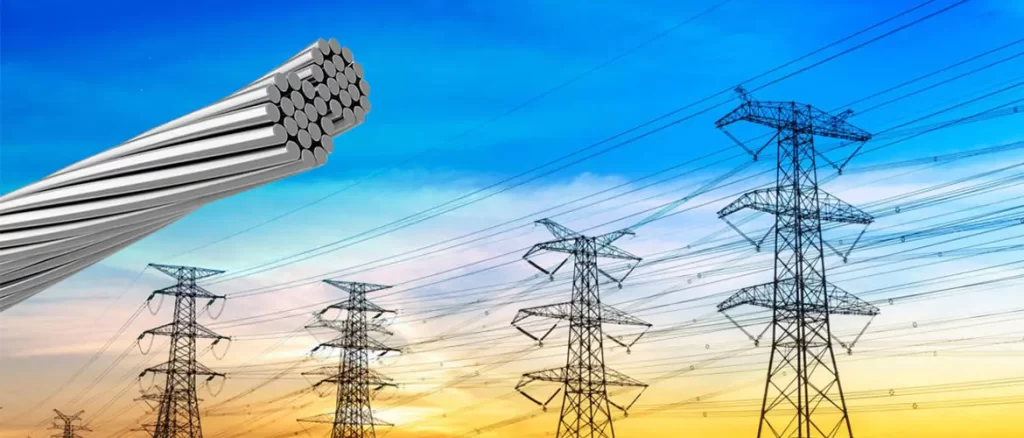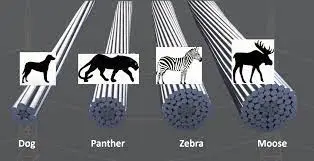ACSR
- According to IEC, BS, AS, NFC
- Packages by drum
- Overhead
Guide to Buying the Right ACSR Conductor
Cables are an essential part of any electrical system. They carry the current from the power source to the load and are responsible for the safe and efficient operation of the system. Not only that, but cables also play a vital role in the transmission and distribution of electricity.
ACSR (Aluminium Conductor Steel Reinforced) is one of the most popular cables used in electrical systems. It is made up of an aluminium core surrounded by steel wires. The aluminium gives the cable conductivity, while the steel provides strength and rigidity. Let’s find out everything about ACSR cables so that you can make an informed decision when buying one.
What Does ACSR Mean?
ACSR is an acronym for Aluminium Conductor Steel Reinforced. ACSR conductor means a cable made up of an aluminium core surrounded by steel wires. Combining these two materials makes ACSR cables one of the most popular choices for electrical systems. They are widely used in transmission and distribution lines due to their high strength and low weight.
When it comes to conductors, aluminium is the best choice due to its high conductivity. However, it is not strong enough on its own and needs to be combined with another material to create a durable and long-lasting conductor. This is where steel comes in. Steel is an excellent choice for reinforcing aluminium because it is strong and has very high breaking strength. The aluminum core’s steel wires give the ACSR conductor high strength and durability.
ACSR core wire is made up of multiple strands of aluminium wire. The number of strands and their diameter depends on the specific application of the conductor. For example, conductors used in high voltage transmission lines will have a more significant number of smaller diameter strands than those used in low voltage distribution lines. The steel wires surrounding the aluminium core are also known as the ‘reinforcing’ or ‘support’ wires.
ACSR conductor is available in a variety of ACSR sizes and configurations. The most common ones are:
- Stranded:
Stranded conductors are composed of multiple strands of aluminium wire. This type of conductor is flexible and has a high fatigue resistance. It is the most popular choice for transmission and distribution lines.
- Compacted Conductors
These are made up of a single strand of aluminium wire. This type of conductor is more economical, but it also has a lower resistance to fatigue. However, it is not as flexible as stranded conductors and is not used in applications where flexibility is required.
- Parallel:
Parallel conductors consist of multiple strands of aluminium wire arranged side by side. This type of conductor has a higher resistance to fatigue than stranded conductors.
What is ACSR, and where do we use it?
A steel-core aluminum strand is a reinforced wire that has one or more layers of aluminum strands strung outside of a galvanized steel core. It’s commonly utilized in the power and transmission line sectors.
Steel core aluminum stranded wire has always been a mainstay in electric power, and in this modern age of advanced science and technology, many industrial development plants have emerged in our world and are constantly with us.
The internal steel core, which is wrapped around the steel core with aluminum wire strand, has a higher strength than that of other alloys; it primarily serves to increase strength while the aluminum strand serves to transmit electricity.
Steel-core aluminum strand is made of three sections: an aluminum core, a steel wire wrapping, and a copper wire covering. It has a very basic structure that is simple to put up and maintain, with low line costs and wide transmission capacity. It’s also effective for covering a variety of surfaces such as rivers, valleys, and other unique geographical conditions where laying is required.
With excellent electrical conductivity and adequate mechanical strength, tensile strength, tower distance can be enhanced. Because of this, it is frequently utilized in overhead transmission and distribution systems with a wide range of voltage levels.
When it comes to electrical systems, ACSR cables are one of the most popular choices. They are widely used in transmission and distribution lines due to their high strength and low weight. The combination of aluminium and steel makes ACSR wire resistant to corrosion and able to withstand extreme temperatures.
ACSR cables are also used in a variety of other applications, such as:
Overhead power lines are the most common application for ACSR cables. They are used to transmit electricity from one point to another. The high strength of ACSR wire makes them ideal for this application as they can support the weight of the power line without sag.
- Electrical substations:
An ACSR electrical substation is a facility where electricity is transformed from one voltage to another. ACSR cables are used in substations to connect the different pieces of equipment. The wires are also used to connect the substation to the power grid.
Why is ACSR Conductor used for overhead lines?
Overhead lines are the most common application for ACSR conductor. The ACSR conductor is solid and lightweight, but it is also resistant to corrosion. This makes it the ideal choice for transmission and distribution lines.
Some of the advantages of using an ACSR conductor are:
High strength-to-weight ratio:
Typically, the ACSR conductor has a higher strength-to-weight ratio than other types. This means that it can support a more prominent weight without sag.
Flexibility:
ACSR conductor is flexible, making it easy to install and remove. The ACSR conductor is less likely to break during installation than other conductors. Using an ACSR aluminum conductor can also reduce the risk of damage to equipment.
High resistance to fatigue:
ACSR aluminum conductor cable has a high resistance to fatigue, which means it can be used in various applications. So far, it is the most popular choice for transmission and distribution lines.
Cost:
Compared to other types of conductors, the ACSR conductor is more cost-effective. This is because it is made up of a cheaper material (aluminum) and does not require as much maintenance. ACSR wire price is also lower than other types of conductors. ACSR, cable price list, can be found online.
Aesthetics:
ACSR conductor is available in a variety of colors. This means that it can be used to match the aesthetic of your home or business. When compared to other types of conductors, the ACSR conductor is more aesthetically pleasing.
Types of ACSR Conductors
Coming in various sizes and shapes, ACSR conductor is available in different types. The most common type of ACSR conductor is used for overhead lines. Other kinds of ACSR conductors include:
- ACSR Bare Conductor:
It is the most common type of ACSR conductor. The name “Bear” comes from this conductor used in overhead lines. ACSR Bare conductor is available in a variety of sizes, ranging from 6 AWG to 27 AWG.
- ACSR Hawk Conductor:
This specific type of ACSR conductor is used in underground power lines. The name “Hawk” comes from this type of conductor connecting the substation to the power grid. ACSR Hawk conductor is available in a variety of sizes, 1/0 ACSR and 4/0 ACSR are the most popular ones.
- ACSR Rabbit Conductor:
Generally speaking, this type of conductor is used in renewable energy applications, such as solar and wind farms. The name “Rabbit” comes from this type of conductor connecting solar panels and wind turbines to the power grid. The weight of ACSR Rabbit conductor is somehow 214 kg/km.
- ACSR Lynx Conductor:
This conductor is used in high voltage transmission lines. The name “Lynx” comes from the fact that this type of conductor can carry a large amount of electricity. ACSR Lynx conductor is available in a variety of sizes, ranging from 18 AWG to 14 AWG. It can support a current-carrying capacity of 520 Amp At 45 degrees Celcius.
However, some other conductor types are available on the market, such as ACSR moose, ACSR dog, ACSR hare, etc. Each type has its specific application. Many get confused with ACSR and acss, so discussing ACSR vs. acss is also essential. The primary differentiation points include:
- ACSR can operate at a temperature up to 75°C, whereas ACSS can only take 60°C.
- The maximum short circuit temperature of ACSR is 250°C. For ACSS, the maximum fast circuit temperature is only 194°C.
- Weight of ACSR is much less than that of the similar-sized ACSS conductor.
- The cost of ACSR is much lower than that of an ACSS conductor.
- ACSR is available in a variety of sizes and shapes. ACSS conductor is only available in round shape.
Why are ACSR Conductors named after animals?
This is because in the early days, different sizes of conductors were used for various applications, and they needed to be distinguished from each other. That’s why multiple animals were chosen, and their names were given to specific sizes of a conductor.
Every ACSR core wire has a different breaking load and weight and can be used for other purposes. Animal names make it easier for people to remember the specific conductor sizes, and the identification process becomes more accessible.
Conclusion:
Finding an ACSR conductor manufacturer is not a problem anymore. You can easily find them online. But, you need to do your research to find the best one. Once you find the best manufacturer, you can be sure that you will get the best quality product at the most competitive price. All the features and specifications described above make ACSR conductor one of the best choices for your electrical needs.
Having an ACSR conductor is a great way to have an efficient and economical electrical system. If you are probing for the best quality product, you should consider ACSR conductor. With so many benefits and features, it is definitely worth your investment.

